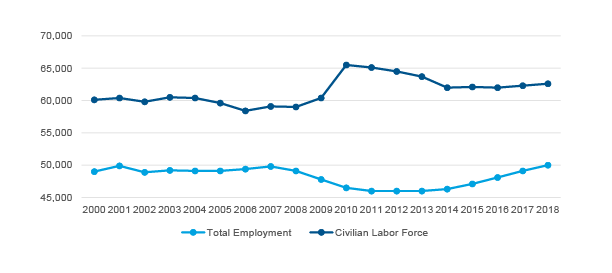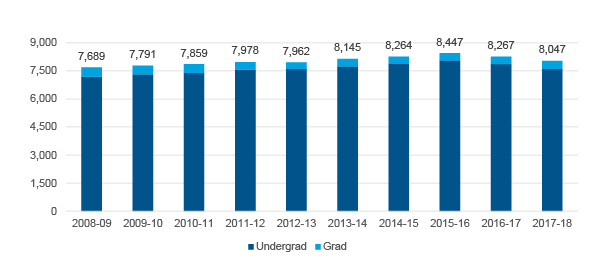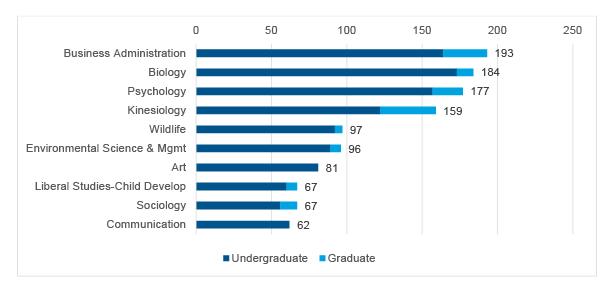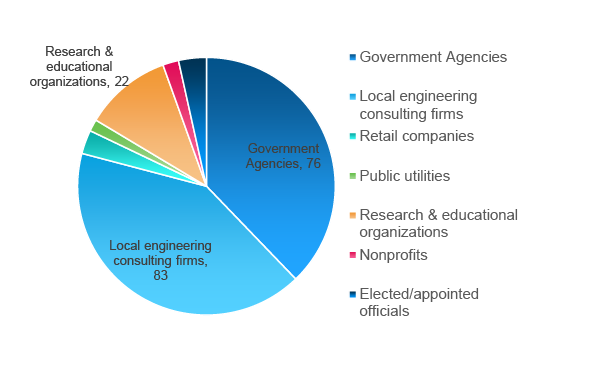You are here
2.3 - Meeting the Needs of the Regional Economy
HSU is the most northern and rural of all the California State University campuses, and as such plays a unique role in the regional economy. Arcata has a population of roughly 18,000, and Humboldt County approximately 136,750. HSU has a student body of around 8,000 students, and therefore contributes as much as 45% of the total Arcata population. In the County the total labor force is 64,400, with an unemployment rate of 3.3%.49
According to the California Employment Development Department, total employment in Humboldt County has been relatively flat over the past two decades, with only 2% growth from 2000 to 2018, as shown in Figure 2. The significant job losses in manufacturing have been offset by increases in service-providing jobs, particularly education, health service and government jobs. While the number of jobs available has been slowly increasing, there have been growing concerns over a decreasing labor force50, a void which HSU students and graduates can help to fill.
Figure 2: Humboldt County Total Employment and Civilian Labor Force

Attracting a Regional Workforce
Humboldt County is a rural region several hours from the closest metropolitan area. Each year HSU attracts the majority of its student body from outside the region, and these students become the future workforce of the region. While roughly 7% of students come to HSU from the local community, 87% come from other areas across California, 4% come from the 13 other Western Undergraduate Exchange (WUE) states, 2% from other parts of the United States, and less than 1% are international students. Enrollment has decreased by 400 students since the peak in the 2015-16 academic year, due mainly to higher high school GPA requirements for incoming freshmen and an increase in prerequisite courses required for transfer students.51 Figure 3 illustrates the trend in HSU enrollment from 2008 to 2018.
Figure 3: HSU Enrollment 2008-2018

HSU estimates that 23% of alumni remain in Humboldt County after graduation. Alumni have had a strong connection to the University as early as the 1920s, supporting HSU by housing current students and providing student loan programs.52 This connection with HSU and Humboldt County continues today, as many HSU graduates go on to become staff or faculty members at the University, serve on local city councils or as mayors, and start local businesses. For example, in Spring 2017 there were over 190 Environmental Resource Engineering (ERE) alumni working in the region, with an estimated additional 300 retired local alumni over ERE’s 50-year history53.
Filling the Workforce Needs of the Region’s Key Industries
HSU prepares graduates for success in the growing industries in the Humboldt region. ICF identified three key sectors of growing importance in the regional economy where HSU has most significant contribution: fishing, forestry, and environmental engineering. These three are given spotlights in this section.
Figure 4 displays the HSU graduation trends from 2008 to 2018. The number of degrees awarded has remained relatively consistent, increasing by an average of 5% each year between AY 2008-09 and AY 2016-17. Between AY 2016-2017 and AY 2017-18 the number of graduates declined by 3%, following the declining enrollment trend.
Figure 4: HSU Degrees Awarded 2008-2018

Highly-qualified graduates use skills honed at HSU to create positive impacts in industries that drive Humboldt’s regional economy. HSU creates and supports the retention of high-quality jobs and wealth in the Humboldt region through its annual graduation of workforce-ready graduates. Moreover, the presence of HSU helps attract new employers to the region who want access to graduates in these rapidly-growing industries. Figure 5 shows the most popular fields of study at HSU, the top three being business administration, biology, and psychology. HSU has a significant number of students who focus in environmental-related fields, such as environmental resource engineering and environmental science and management.
Figure 5: HSU Top 10 Degrees Awarded, AY 2017-18

Business-related positions are consistently a significant source of jobs in Humboldt County, employing nearly 30% of employed residents in 2018.54 Business administration at HSU has consistently been one of the most popular majors, with about 10% to students earning degrees in the area of study each year.
Two growing industries in Humboldt County that have been facing labor shortages are social work and healthcare. In the Arcata area there is approximately one psychiatrist for every 4,600 residents, demonstrating the shortage felt by the community.55 Between 2009 and 2018 the number of social workers56 in Humboldt County increased by 77% to 3,500 social workers, though it is still not enough to meet growing demand.57 In 2018 HSU graduated over 750 undergrads in social work/psychology, and 119 graduate students. These students have the potential to go one the serve those in need in the region, in positions like community and social service specialists and mental health specialists. The shortage of healthcare professionals in the Humboldt region is a long-standing issue that many rural communities face. In early 2018 the California Healthcare Workforce Policy Commission considered registering Humboldt County as a nursing shortage area because of evident issues like long emergency room waits and patient care violations.58 From 2009 to 2018, the number of healthcare professionals increased by 14%,59 however again this growth is not keeping up with community need. The number of registered nurses in the North Coast region is expected to continue to increase by about 2% annually up to 2024.60 While not specific to nursing, HSU’s numerous biology graduates can play an important role in meeting the community need for health care professionals. In AY 2017-18, 173 HSU students graduated with biology degrees. HSU unfortunately had to cut its nursing program in 2011, further exacerbating the nursing shortage, though the university plans to reopen the program in 2020.61 See Community Health and Wellness discussion in Section 5.1 for more details.
In 2018, the education sector employed 9% of the total working population in the County.62 With a roughly 2% annual growth rate from 2009 to 2018, the education sector will continue to demand qualified teachers. Education/child development is one of the top 5 most popular majors among HSU students, with over 110 undergraduates and graduates earning degrees in the education field in 2018. Additionally, HSU offers credential programs in elementary, secondary, and special education, as well as an Educational Leadership credential program for processions currently working in schools. All three programs focus on preparing education professionals to serve in California schools and to work directly with youth of diverse ethnic, socioeconomic, and cultural backgrounds.63 The total enrollment in these credential programs in 2017 was 98 students, a 4% increase from the previous year. 64
HSU graduates support the growth of key regional industries, the three most prominent of which are are forestry, fishing, and environmental engineering. The snapshots below provide a detailed look at each industry in Humboldt County and HSU’s contributions.
Forestry Sector
Historically, the timber industry has been a large contributor to the Humboldt economy. Since the early 1990’s the industry has been in decline, due to prior clear cutting and a rise of environmental activism.65 This has led to the perseveration of the Redwoods, but also significant losses in mill jobs. Lost mill jobs are rapidly replaced by new positions in forest conservation, such as natural resource technicians, environmental planners, and restoration ecologists. In fact, forest-related employment, such as forest conservation workers and foresters, increased by 123% between 2009 and 2018,66 signifying the vast expansion in the industry.
HSU plays a significant role in the region’s forestry industry, namely through the attraction of talent to the region due to its campus facilities and programs. From 2010 to 2014 the HSU Forestry and Wildlife department has averaged an intake of 50 freshmen and transfers each year, and anticipates enrollment growth.
HSU facilities draw talent to the region while offering unique training opportunities. The HSU Wildland Fire Lab is among the most well-equipped fire research facilities in the country. The University is one of only three schools to have a fire lab complete with a fire platform and ventilation hood67. A recent project undertaken at the Wildland Fire Lab looked at the impacts of prescribed fire treatments at Whiskeytown National Recreation Area and the Sierra Nevada Stanislaus Experimental Forest, such as insect survival and vegetation response to fire.
Redwood Rising is a new collaboration program between the HSU Forestry department, Save the Redwoods League, the National Park Service, and California State Parks. During the summer of 2018, eight Humboldt students participated in the apprentice program, setting out to restore 80,000 acres of young, densely-growing redwoods in the local area.68 During the school year, the semester-long internships gives students a choice of focusing on fire management, rare and invasive plant surveys, or a phenology project for their 90 hours of field work. Given the rich and unique hands-on experience afforded by the program, many students have been hired after completing their internships.69
HSU graduates impact on the forestry industry in the region is evident. Take for example Green Diamond Resource company. In a 6-month span in 2008, this 118-year old forest product company filled 31 of its 43 management and technical positions with HSU graduates and students.70 Today, at least 30 HSU alumni work at the Green Diamond Resource company.
Fisheries Sector
Fishing has long since been an important sector in the Humboldt-regional economy, and HSU has played a significant role in supporting the industry. By 1970, over half of the fish produced and consumed in California were landed in Humboldt Bay, while recreational fishing further supported the local economy.71 A recent study, published in 2018 by HSU Professor Laurie Richmond and team, showcases the growth of Humboldt’s oyster industry. As the oyster capital of California, Humboldt Bay’s bivalve industry’s local economic impact in 2016 was about $20 million in direct and indirect impacts. The industry provides about 100 full-time jobs, with expansion plans over the next five years.72 The industry often collaborates with HSU graduate students on research projects and other HSU activities. Of the three oyster companies with employment information available online, Coast Seafoods Company, Hog Island Oyster Co, and Aqua-Rodeo Farm, all have at least one employee that is an HSU alumnus.
HSU’s undergraduate fisheries program is one of the largest and best in the United States. It is also the only fisheries management type program in California, and one of only a few west of the Rocky Mountains.73 Fisheries biology graduates go on to work with state Fish and Game agencies, federal agencies, and numerous private and consulting firms.
HSU regularly collaborates with government agencies to have a greater impact on the regions fisheries and ecosystems. The California Cooperation Fish and Wildlife Research Unit is a collaborative effort between HSU, the California Department of Fish and Wildlife, the United States Department of the Interior, Geological Survey, the Wildlife Management Institute and the United States Fish and Wildlife Service. The cooperative program creates an opportunity for research to be conducted to support and restore fish and their ecosystems, as well as training graduate fisheries and wildlife management students to become competent fisheries and wildlife scientists74. Research topics vary widely, one example being a project from 2008-2013 that examined the declining Pacific salmon populations in the local Klamath River.75
A notable ongoing program in the Marine Mammal Education and Research internship program is the Stranding Network. Led by an HSU grad student, students systematically walk every beach in Humboldt County looking for stranded marine life. The group is developing and sampling protocols for the entire North Coast region, and potentially all of the western United States.76
Engineering & Energy Sectors
Graduates from HSU’s Environmental Resources Engineering (ERE) program have found themselves filling positions in a wide variety of industries in the region following graduation. As shown in Figure 6, these industries include government agencies, local engineering consulting firms, retail companies, public utilities, research and educational organizations, and nonprofits, Notably, 55 ERE grads currently work for Caltrans, and most of the retail workers own or have cofounded their companies (ERE Messenger, Spring 2018). Engineering occupations are expected to increase over 1% annually until 2024 in the North Coast region77, likely with many HSU grads filling the positions.
Environmental Resource Engineering at HSU is one of the oldest and largest environmental engineering programs in the United States. In fact, HSU graduates 5-10% of the nation’s graduates from accredited environmental engineering programs.78 While at HSU, students support the community while gaining the skills need to be successful in their future careers. At the Arcata Marsh and Wildlife Sanctuary students research and identify operational strategies for treatment marshes to improve solid and biological oxygen demand inefficiencies. One of the main community assets of ERE student and faculty research is the Schatz Energy Research Center, further discussed in Section 3.3.
One of many HSU ERE grads leading organizations with significant community impact is Matthew Marshall. Matthew is currently the Executive Director of the Redwood Coast Energy Authority (RCEA), a joint powers agency founded in 2003. Along with Matthew, the RCEA currently employs 25 other HSU graduates.79 RCEA has worked closely with HSU’s Schatz Energy Research Center to develop renewable energy-powered microgrids in the region, and is currently leading the coordination effort to plan and research offshore wind development off Humboldt Bay. With 100-150megawatt capacity, the Redwood Coast Offshore Wind Project would allow the region to obtain more locally generated energy, and diversify California’s renewable energy portfolio. A recent report from the Center for Labor Research and Education at the University of California, Berkley suggests that offshore wind energy could play a leading role in creating green, quality jobs that also benefit the community.80
Figure 6: ERE Graduate Jobs, As of Spring 2018

Regional Leadership
HSU students often develop a strong connection with the Humboldt region while at school, and many go on to take up leadership roles in regional businesses, government, and community organizations. Currently there are 76 local ERE graduates that work in government agencies at the local, tribal, state, and federal levels. In fact, the three highest ranking engineers in Humboldt County city governments are all HSU graduates. Michael Winkler, at 1997 ERE graduate, has served on the Arcata City Council since 2008. During that time, he has served two terms as Mayor, and two as Vice-Mayor.
The Arata City Council is filled with HSU graduates, as it has been for years. Currently four of the five council members are HSU alumni, with the one outlier coming from another CSU. Four of the five most recent Mayors of Arcata have been HSU alumni, all of whom incorporated the sustainability culture of HSU into their initiatives during their time as Mayor and City Council members.
The 2018 Mayor, Sofia Pereira, a recent HSU graduate who was featured on the CSU website, discussed how her time at HSU influenced her actions in her role as Mayor. Pereira graduated from HSU in 2009 with a major in communications and minor in social advocacy. While at HSU Sofia was a member of the speech and debate team and became the president of Associated Students at HSU. After graduation she interned and worked on local political campaigns, leading her to the Arcata City Council and election as Mayor in December of 2017. Even now she is the youngest member of the City Council. Pereira has many goals for the city that were shaped by her time at HSU, such as her Zero Waste Action Plan. Pereira stated that the environmental stewardship and sustainability focused culture at HSU influences her still, saying “[My time on campus] inspired me to further work on issues surrounding climate change, including energy usage, water conservation and waste diversion." Aside from being Mayor, Pereira also services as the community managers of a nonprofit aimed at getting more women into politics, She Should Run.81
HSU alumni go on to start and grow companies that meet the needs of the regional economy. In the field of social services for instance, HSU alumna Brandie Wilson (’09, Sociology, ’11, M.A. Sociology) founded the Humboldt Area Center for Harm Reduction (HACHR), a non-profit seeking to improve Humboldt County’s overall rating on the Health Community Index. Former business administration student Tim Rine, who graduated from HSU in 1997, now serves as the executive director of the North Coast Clinics Network (NCNN). NCNN is an association of community health centers that support underserved resident in Humboldt, Del Norte, and Trinity counties. Health care is an area of growing need in the region, and HSU students are able to help support those in need through knowledge of rural health care and social justice.82
- 48 HSU EOP. https://eop.humboldt.edu/
- 49 State of California. Employment Development Department, Humboldt County Profile,
https://www.labormarketinfo.ed...
lectedindex=12&menuChoice=localAreaPro&state=true&geogArea=0604000023 - 50 California Economic Summit, Humboldt County: An Economy in Transition, 2018 http://caeconomy.org/reporting...
- 51 HSU. We Are Here. A Snap Show of HSU’s Current Conditions, Circumstances, and Influences, 2018. https://ie.humboldt.edu/sites/...
- 52 Jarad Petroske. HSU Alumni, Who They Are. Where They Are. And Where They’re Going., 2011, http://magazine.humboldt.edu/f...
- 53 ERE Messenger, Spring 2017
- 54 State of California. Employment Development Department. Employment and Wages by Occupation (OES). https://www.labormarketinfo.ed...
- 55 HSU. We Are Here. A Snap Show of HSU’s Current Conditions, Circumstances, and Influences, 2018. https://ie.humboldt.edu/sites/...
- 56 Number of people employed in community and social service occupations. Source State of California. Employment Development Department. Employment and Wages by Occupation (OES). https://www.labormarketinfo.ed...
- 57 State of California. Employment Development Department. Long-Term Occupational Employment Projections. https://data.edd.ca.gov/Employ...
- 58 Redwood Times. State may spotlight Humboldt County’s nursing shortage. 2018. https://www.redwoodtimes.com/2...
- 59 State of California. Employment Development Department. Employment and Wages by Occupation (OES). https://www.labormarketinfo.ed...
- 60 State of California. Employment Development Department. Long-Term Occupational Employment Projections. https://data.edd.ca.gov/Employ...
- 61 North Coast Journal. HSU Hope to Open New Nursing Program in 2020. 2019. https://www.northcoastjournal....
- 62 State of California. Employment Development Department. Employment and Wages by Occupation (OES). https://www.labormarketinfo.ed...
- 63 HSU School of Education. Credential Programs. https://education.humboldt.edu...
- 64 HSU. Fast Facts 2017. https://ie.humboldt.edu/fast_f...
- 65 North Coast Journal. Humboldt Then and Now. 2015. https://www.northcoastjournal....
- 66 State of California. Employment Development Department. Employment and Wages by Occupation (OES). https://www.labormarketinfo.ed...
- 67 HSU. Wildland Fire Lab. http://www2.humboldt.edu/firel...
- 68 Save the Redwoods League. Redwoods Rising Apprentices Hep Restore Redwood National and State Parks. 2018. https://www.savetheredwoods.or...
- 69 Interview conversation with Kacie Flynn, Executive Director, HSU SPF
- 70 HSU Now. Natural Resource Jobs in High Demand. 2008. http://now.humboldt.edu/news/n...
- 71 Eureka Fishing Community Profile. 2010. https://caseagrant.ucsd.edu/si...
- 72 HSU Now. Study: Humboldt Bay Bivalve Businesses Has a Big Local Impact. 2019. http://now.humboldt.edu/news/s...
- 73 HSU. Fisheries Biology. https://www.humboldt.edu/progr...
- 74 HSU, California Cooperative Fish & Wildlife Research Unit, https://cuca.humboldt.edu/
- 75 Cooperative Research Units. Klamath REMS, Fisheries. https://www.coopunits.org/Cali...
- 76 HSU Stranding Network. https://sites.google.com/site/...
- 77 State of California. Employment Development Department. Long-Term Occupational Employment Projections. https://data.edd.ca.gov/Employ...
- 78 HSU. ERE’s Top Ten Highlights. https://engineering.humboldt.e...
- 79 Redwood Coast Energy Authority LinkedIn employees. https://www.linkedin.com/compa...
- 80 University of California, Berkley. High Road for Deep Water. 2017. http://laborcenter.berkeley.ed...
- 81 CSU. Sofia Pereira. https://www2.calstate.edu/impa...
- 82 HSU Now. Meet our 2018 Distinguished Alumni!, 2018, http://now.humboldt.edu/news/m...